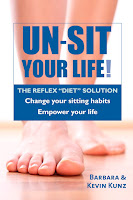What’s this? Paleo man and woman are the reasons we women today face the unwelcome specter of big behind and pot belly? And, we can do something about it? What’s going on here?
We are our ancient ancestors, body-wise that is. And, this creates problems for the figure we desire. There is a mismatch between what our bodies do all day and what they are designed to do. As our chair dwelling lifestyles meet our paleo-designed muscle and skeletal systems, the result is a series of events leading to big behind and pot belly. (There’s also paleo metabolism and weight gain but that’s a discussion for another time.)
Muscles meant to be up and moving now live a life of sitting. Particularly impacted are muscles that keep in place the hips and lower back, the hip flexors. With too much sitting these muscles shorten and tighten pulling the hips forward. The result? The buttocks are thrust out creating the big behind.
The culprit is implicated as well in the notorious pot belly. You see your abdominal muscles work together with your back, leg and hip muscles to keep you upright as you walk. Abdominal muscles weaken as they are under-utilized by too much sitting. No longer held in place by tight abdominal muscles, the belly comes to protrude.
Consider how much you sit. Sitting less and moving more will interrupt the pattern that creates big behind and pot belly. Also, as we sit, the fat cells of the buttocks become compressed by the body’s weight. Sit too much and the fat cells enlarge and spread.
We often take breaks from reading the computer to save our eye but consider how often you take breaks from sitting. You probably don’t even think about it!
But imagine this: taking breaks from sitting has more to do with a smaller waistline size than exercise according to research! Those who take the most breaks from sitting actually have smaller waistlines! Some by as much as 1.6 inches smaller (in one study). Oh the joy!
Taking action: Target the hip flexors
The great thing about exercises and stretches targeting the hip flexors is that they are multi-purpose, working to lessen big butt syndrome as well as helping back pain and “age-proofing”. Tight hip flexors are a major cause of back pain as the back hyperextends when the hips are pulled forward. As years go by, such frightening tightening results in the lower back becoming a less stable platform for standing and walking. Created are risks for falls and lessened abilities to get around in old age.
Exercises and stretches that target the hip flexors are variations on the lunge where one leg is moved in front of the other into a position of a 45˚ angle.
As you consider the exercises described below, take care to work within your comfort zone. If you have knee problems, consult with a health professional before proceeding. If you have balance problems, consider working with the stretches only.
If you have not exercised recently, start slowly. Spend a week or more trying the stretches. Consider how they feel especially the lunge stretch.
The stretches can be done every day. However, exercises should be done every other day to allow muscles to recover. Start with fewer repetitions and build up to more. Rest between exercise sets. Alternate lunge exercises with exercises targeting muscles other than those used during the lunge to allow recovery.
Stretches
Hip flexor stretch
Sit on the floor with the soles of your feet touching. Sit comfortably for a minute.
The bridge stretch
Lie on the floor. Raise the center of your body upward while keeping feet and shoulders in place on the floor. Stay in place for a moment.
Lunge stretch
Kneel on the floor. Extend your right leg forward moving into a lunge position with knee bent at a 90˚ angle.
If it is difficult for you to maintain your balance, position yourself between an ottoman and a chair so you are supported as you move into position. Begin by holding the stretch for one minute and build up.
Reposition with the left leg in a lunge position. Hold for a minute.
Practice until you can independently balance in the lunge position.
Exercises
The lunge stretch/exercise
As you feel more comfortable with the stretches or want to start with the exercises, practice the lunge stretch for a longer period of time. Move into position as described above. Now hold the lunge for 3 minutes. Change legs and hold for 3 minutes. (My lower back discomfort was instantly eased by this 3-minute stretch. It also helped with my competence in doing the following lunges.)
Pendulum lunge
Stand holding a chair with your right hand. Step forward with your right foot moving into a lunge position with knee bent at a 90˚ angle. Stand upright. Step back with right foot and extend it so your left leg is at a 90˚ angle. Repeat. Build number of repetitions to 8. Repeat with left leg.
Mobility lunge
Once you feel comfortable with the pendulum lunge, try the mobility lunge. This lunge may be a challenge for both maintaining balance and leg strength. The pendulum lunge helps build strength. Position yourself between an ottoman and a chair or by a chair to ensure balance.
The description below is from a Men’s Health article. The mobility lunge is described as helping flexibility of the hip flexors.
“… Assume a lunge position with your right leg forward and both knees bent 90 degrees. Place your hands on your right thigh and push down to activate your core. Then place your hands behind your hips. Flex your glutes as you push your hips forward and down, feeling the stretch in your left hip. Hold for 5 seconds, and return to the starting position. That’s 1 rep. Do 5 reps, switch legs and repeat.”
Easter, Michael, “4 Mobility Exercises To Build Your Strength And Power, Build an athlete's body with these four power moves,” July/August 2014, pp.100-103
















